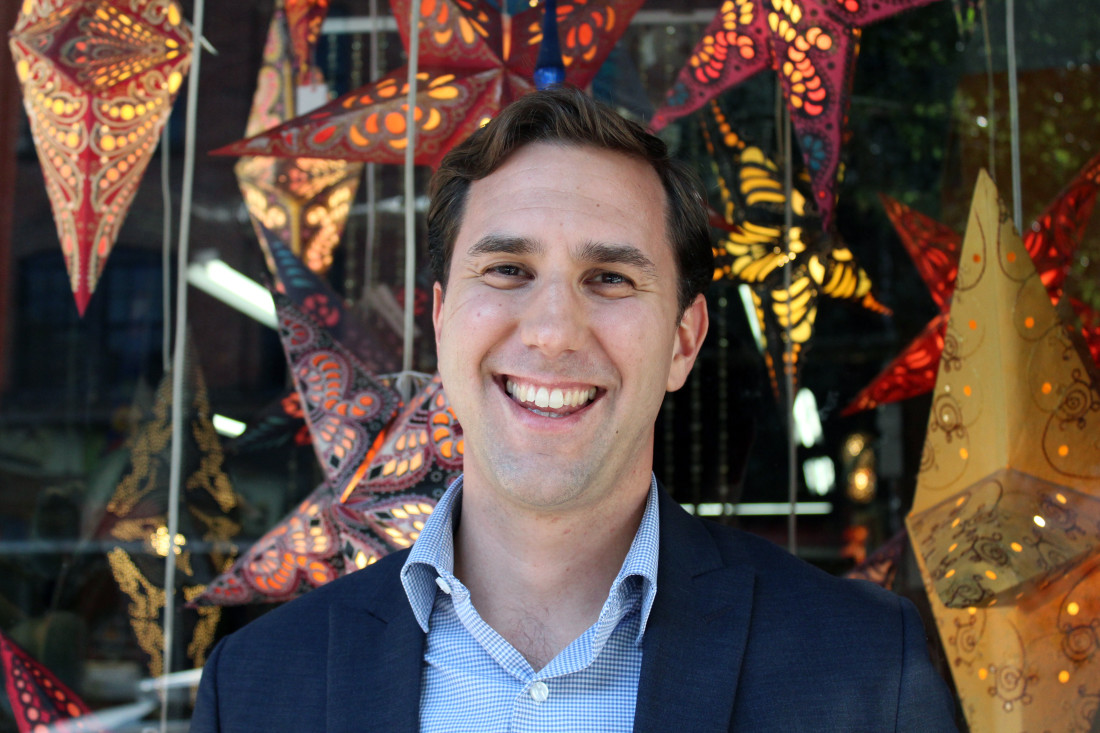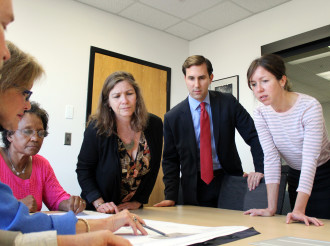“There are no one-size-fits-all solutions in planning: Each place is very different,” says Todd Okolichany, who began work as Asheville’s new planning director Sept. 8. “That’s a key value for me as a planner: recognizing the differences and uniqueness of each place.”
Okolichany, 36, comes to Asheville from Fort Lauderdale, Fla., where he was principal planner for the city’s Sustainable Development Department. Xpress caught up with the fast-moving Okolichany (he says it’s fine to call him “Todd O”) recently for a chat and a stroll around downtown. Here are excerpts from that conversation.
Mountain Xpress: Where are you living?
Okolichany: My wife and I had a short time frame to find a place for us and our two kids, so we ended up renting in Fletcher. We hope in the next year to purchase a home in the city. It’s true that the housing supply is limited in Asheville, but I’m enjoying getting to know the neighborhoods: There are so many great parts of this city.
What strikes you as unique about Asheville so far?
The high level of public involvement and the involvement from so many different groups. I’ve been impressed at the meetings I go to, seeing how many people attend and how interested and informed they are. I get a sense that people really care about this city and want to get involved. We need to hear every side of the story when we tackle the tough issues that come with growth and change, and I see that happening here. I don’t just see one side dominating the conversation.
Let’s hear a fancy-schmancy city planning term and how you think it applies to Asheville.
“Tactical urbanism” is where the city and residents make low-cost, not necessarily permanent changes in how we use city spaces. The garden at the end of Lexington Avenue is a good example — community members improved a barren space using natural materials like rocks, plantings and mulch to create a welcoming garden. Asheville’s wonderful murals are another great example of the kinds of simple interventions that make a big difference in how the city feels.
In Fort Lauderdale, we created a pop-up dining area on the beach. Because the infrastructure is minimal, there’s not a lot of risk related to storm damage. I can see something like that being a good fit with the River Arts District, as a way to connect the waterfront with the businesses set farther back.
What about street performers downtown?
One of the things that attracted me to Asheville is its vitality. Any night of the week, it’s such an active downtown. A lot of other cities are struggling to get that same effect. The busking community creates so much of that liveliness we value downtown.
At the same time, we’re trying to serve multiple users and keep pedestrians moving along the sidewalks, while also accommodating street furniture, lights, trees and vending carts.
We need to make sure that we’re speaking with all the groups that use the downtown spaces, whether they live here or are tourists. One of the interesting aspects of planning is that it takes a while to get to the final recommendation. We’ll facilitate an open public process to make sure the buskers’ craft is still very successful but is managed in a way that balances all of downtown’s other needs.
What are your thoughts on the city-owned lot across from the Basilica of St. Lawrence?
My understanding is that the city is working with the Chamber of Commerce on potential development opportunities for the site. As that process moves along, we need to look at not just the development site itself but also the whole area to see what uses work well together. There’s definitely a way to do that while respecting the basilica’s architecture and history. Realigning the roadway is another consideration we need to study.
In cities throughout the country, public spaces like parks and sidewalks have become an extension of our private spaces. So we need to look at uses that recognize and support that function, like sidewalk dining.
How many parks are enough?
First we need to determine how many people the parks we already have are serving. Pack Square is very different from Pritchard Park: Pack is more open and linear, while Pritchard is more intimate. Pack Square is so successful when we’re hosting events and festivals, and at certain times of day when kids are playing in the fountains, but at other times there’s less use. Some of the vacant ground-level spaces in the surrounding buildings offer opportunities to activate Pack Square more and attract more users.
What can Asheville do to fix its affordable housing crisis?
This will take not one strategy but a whole toolbox of approaches. Our first step will be evaluating the city’s current zoning ordinances to be sure there aren’t regulatory impediments. We’ll look at opportunities for infill-type development, where we can incorporate smaller multifamily or townhouse units in existing neighborhoods.
We must keep encouraging the development of housing in general. Asheville needs both affordable and market-rate housing. Tiny homes are growing in popularity; we should look at our zoning ordinances to see where they might fit in.
We must also ensure that affordable housing is located in areas where public transit or other multimodal transportation options are available.
What’s your take on short-term rentals and homestays?
I’m getting up to speed on this issue. I’ve been to some public meetings where it’s been discussed. We’re refining the city’s plan to expand opportunities for residents to offer homestays within their primary dwelling for short-term guests.
As the market changes and new technologies come along, cities must constantly evolve to manage new land uses. We’re working to ensure that our homestay regulations will maintain the character of residential areas. And of course, providing homestays to short-term visitors shouldn’t conflict with the city’s broader affordable housing goals.
We also have to keep an eye on the state Legislature. This is my first time in a Dillon’s Rule state, so I’m learning what we as a municipality can and cannot do.
How can Asheville encourage bicycle transit?
The city is actively engaged in this process, from the Transportation Department’s Asheville in Motion plan, which looks at all different modes of transit, to new road construction incorporating bike lanes in the River Arts District. The city has been identifying different types of roadways and looking at how they’re used, including the possibility of introducing buffered bike lanes on roads with higher vehicular traffic.
Fort Lauderdale has a successful bike-sharing program. Wouldn’t it be wonderful to offer tourists as well as residents and downtown workers the option of using a shared bike to get around Asheville?
We can look at encouraging or requiring bike amenities in new development, such as bike parking spaces, integrated secure bike storage and facilities for bike commuters in office buildings.
Big picture, what’s one major focus for you this year?
We’ll be updating Asheville’s comprehensive plan. Staff is working on drafting a request for proposals for consulting services.
The plan will provide a blueprint for sustainable growth and development over the next 20 years and beyond. It will establish a vision for the city and will include goals and strategies reflecting community desires about how and where the city should grow, future land-use patterns and other policy guidance, while ensuring there’s sufficient infrastructure, parks and community services. A major goal is providing a strong platform for sustainability while maintaining a high quality of life where all residents and businesses can be successful.





Ironic they pick a newbie to come here to DIRECT planning for the next 20 years…was there NO ONE on staff to
take this JOB ??? With apologies to Todd O, this is another example of pathetic NON leadership in Asheville.
He’s earned AICP certification. I doubt anyone else on the city staff has.
When the new city planner speaks of tiny homes, is he referring to something like the cargo ship container configuration on River road just north of 12 Bones or something lighter looking in modular design?
And for bikes, that’s great for Fort Lauderdale, my growing up years ago in West Palm Beach. But having retired from New Jersey, the roads down here are more dangerous in the winter than in New Jersey, let alone for bike riders. There always seems to be a lack of interest in Buncombe county to totally clear the roads, which allows dangerous black ice to form off and on from late December into March for almost 1/4 of the season.
Having now lived in Buncombe County for over a decade, I suggest the new planner looks into downtown traffic on popular streets. It can be horrendous on Friday and Saturday nights, reminding me sometimes of an effort to get across town on Manhattan during rush hour. And for the first time this year, we found the parking garage next to the Diana Wortham Theatre full. Retired people with weakening knees do not want to park across from city hall or in garages over near the exhibition center to walk to the center of Asheville even when the weather allows, having then to walk back to their cars between 10 and 11 P.M. at night.
I wish him well because Asheville has never seemed to be a friend to change. As an example, having visited Charleston, we have found it to be a wonderful city where everyone seems to be welcomed with the kind of diversity that reminds one of a melting pot. While in downtown Asheville, however, one may find some city residences that would have no problem saying to folks, “if you don’t like it here, don’t let the door hit you on the way out. ”
So people that retire here can find themselves at odds with a sometimes intolerant city life where diversity is how locals define it, the word faux needed for some clarity. Having worked for a decade in a large manufacturing area of the Midwest, I know what a real melting pot society looks like as written by the famous American storyteller, Jean Shepard, who worked at one time in the same steel mill I did for a summer.
Good luck, Todd O. You will need it.